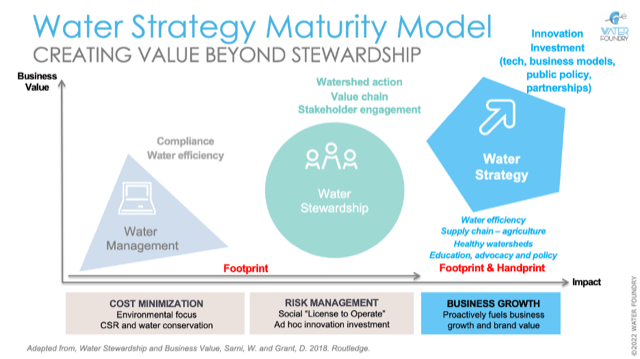Corporate Water Strategy: Where We Were and Where We're Going
When it comes to water management, compliance and stewardship, where did we start and where are we going?
After over twenty years of experience in corporate sustainability and water strategy consulting, it is clear that water management and regulatory compliance alone is no longer a viable corporate water strategy. There is now a pressing need to address “outside the fence line” water issues, such as scarcity, poor quality, inequity in access to safe drinking water, and the impacts of climate change. While regulatory compliance for water and associated management practices are the cornerstone of a corporate water strategy, they do not deliver the full value to corporations, communities, and other stakeholders.
My view is that one of the initial, and perhaps the most publicized, water stewardship strategies was The Coca-Cola Company’s (TCCC) “Replenish” strategy. In 2007, TCCC set an aspirational 2020 goal to safely return to nature and to communities an amount of water equivalent to what the company uses annually in all its beverages and their production (Water Stewardship and Replenish Report, 2011). They beat their 2020 goal by five years (Beverage Daily, 2016). In 2016, this strategy and set of goals achieved replenishment of approximately 191.9 billion liters of water to local watersheds and communities across 71 countries—which, according to the company, was the equivalent to 115 percent of the water used in its finished beverage products the previous year.
This was a pivotal event in moving from water as regulatory compliance and “inside the fence line” management issue. Since the launch of TCCC’s replenish strategy, many more companies have moved to water stewardship strategies and some also framed their strategies as “replenish.”
Where We Are: Water Stewardship and Net Zero
Water stewardship has taken root with most multinational companies across a range of industry sectors adopting this strategy to manage risks outside the fence line. Water stewardship is no longer only a strategy for consumer-facing companies. Now sectors such as mining, semiconductors, heavy manufacturing, and information and communication technology companies are building leading water-stewardship strategies.
However, we are again at a pivotal stage in how companies manage water as a critical resource for their supply chains, operations, and engagement with their customers, communities, and workforces. There are two trends that I consider to be significant in this regard: The move to “net zero” for water (GreenBiz, 2022) and a focus on watershed health.
First, net-zero for water. Several companies are now approaching water strategy in a similar manner as they approach climate change. The primary challenges with a net-zero strategy for water are that: 1) water is not fungible, and the spatially and temporally dynamic nature of water means that, unlike a common, global carbon pool, water is not the same from one location to another; and 2) net-zero is a concept rooted in target-setting and reporting. Water is more complex than carbon and has attributes, such as social and spiritual dimensions, that make a net-zero strategy for water more complex.
Second, a focus on watershed health initiatives. Companies such as PepsiCo and ABInBev are focusing on investments in watershed health to build sustainable and resilient communities and supply chains (PepsiCo and Water and Water Stewardship | AB InBev). This is an important movement and focus as several companies are looking at watersheds holistically and supporting the scaling of innovative digital technologies to measure water quality, quantity, supply chain performance, and productivity on a real-time basis.
Where We're Going: Innovation and Impact
Companies are increasingly focusing on investment in technology innovation and quantifying the positive impact of their water stewardship strategies. This trend is driven largely by the launch of corporate venture and innovation programs designed to accelerate the identification and deployment of innovative technologies. For example, ABInBev launched the 100+ Accelerator and PepsiCo launched PepsiCo Labs. Notable is that the 100+ Accelerator program now includes The Coca-Cola Company, Unilever, and Colgate Palmolive.
Companies are also focusing on how digital technologies can deliver real-time data in watersheds to better manage crop productivity (CropX), water use (N-Drip), and surface water quality (Gybe Water Quality). This trend will continue as companies better integrate water strategies into their business strategies to support growth and build sustainable and resilient supply chains and communities in which they operate.
The journey from water management to water stewardship to water strategy, fully integrated into a business strategy, is illustrated in Figure 1, below.

Water is no longer solely an issue of regulatory compliance. It is now a critical resource that fuels business growth, economic development, social well-being, and ecosystem health.
Going forward, we must accelerate how multinationals engage with innovation in public policy, technology, education, and awareness, and increase diversity and entrepreneurship in the water sector. There are a few companies bold enough today to venture into investing in changing the status quo beyond current strategies to reduce their water footprint. There is an opportunity to do more. And we must capitalize on it now.
TOP PHOTO: Inge Maria | Unsplash
About the Author:
Will Sarni
Founder & CEO, Water Foundry
Founder & General Partner, Colorado River Basin Fund
Read perspectives from the ISSP blog



